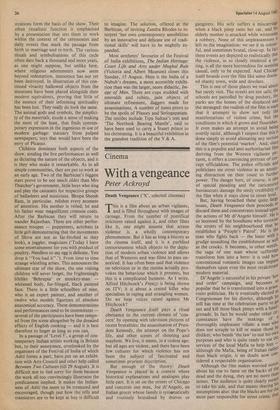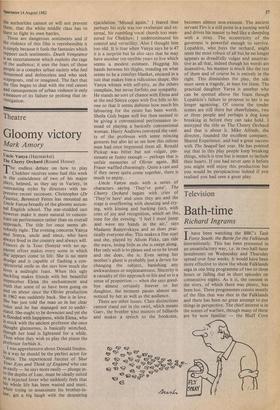Cinema
With a vengeance
Peter Ackroyd
Death Vengeance ('X', selected cinemas)
his is a film about an urban vigilante, and is filled throughout with images of carnage. From the number of pontifical strictures raised against it, and other films like it, one might assume that screen violence is a wholly contemporary phenomenon. But it has as long a history as the cinema itself, and it is a purblind censoriousness which objects to the depic- tion of modern urban violence and allows that of Westerns and war-films to pass un- noticed. It has often been said that violence on television or in the cinima actually pro- vokes the behaviour which it presents, but this is a complicated business. As I write, Alfred Hitchcock's Frenzy is being shown on ITV; it is about a crazed killer who specialises in raping and strangling women. Do we hear voices raised against Mr Hitchcock?
Death Vengeance itself pays a ritual obeisance to the current, climate of 'con- cern' by opening with television pictures of recent brutalities: the assassination of Presi- dent Kennedy, the attempt on the Pope's life, and other scenes of shooting and mayhem. We live, it seems, in a violent age; but all ages are violent, and there have been few cultures for which violence has not been the subject of fascinated and sometimes prurient description.
But enough of the theory: Death Vengeance is placed in a context where historical explanations and analogies play little part. It is set on the streets of Chicago and concerns one man, Joe di'Angelo, an Italian grocer whose family is systematically and routinely brutalised by thieves or
gangsters. His wife suffers a miscarriage when a black pimp rams her car, and his elderly mother is attacked while witnessing a robbery. None of this unpleasantness is left to the imagination: we see it in colour ful, and sometimes brutal, close-up. In fact these events are depicted so realistically that the violence, in so closely rendered a set- ting, is all the more horrendous for seeming casual, only to be expected. And Chicago itself broods over the film like some doom- ed shanty town, wide and desolate. This is one of those places we read about but rarely visit. The streets are not safe, the schools are patrolled by drug pushers, the parks are the homes of the displaced and the deranged: the realism of the film is such that it attempts to show not only the manifestations of violent crime, but the conditions in which it grows and flourishes. It even makes an attempt to avoid being overtly racist, although I suspect that this is done simply to avoid alienating any section of the film's potential 'market'. And, since this is a populist and anti-authoritarian Oil deriving from the Western vigilante Plc" tures, it offers a convincing portrait of cor- rupt officialdom. The police officials and politicians see street violence as an ann0Y- ing distraction on their route to further power. The danger here, of course, is one of special pleading and the caricatured bureaucrats damage the seedy credibility of the film when it stays close to street level. But, having broached these quite large issues, Death Vengeance then proceeds 10 discard them and concentrates instead upon the actions of Mr di'Angelo himself. He Is so incensed by the hoodlums who terrorise the streets of his neighbourhood that he establishes a 'People's Patrol'. He is the man who fights back — the loner with 0 grudge assaulting the establishment as well as the crooks. It becomes, in other words, the saga of one man whose sufferings transform him into a hero: it is odd howl conventional romantic images can impose themselves upon even the most recalcitrant modern material. Di'Angelo successful in his private 'la"' and order' campaign, and becomes s° popular that he is transformed into a grass- roots politician. He is eventually elected as Congressman for his district, although he still has time at the celebration party to g° out and kill three black pimps with a hand' grenade. In fact he would under other cir- cumstances have the makings of 3 thoroughly unpleasant villain: a man vill° does not scruple to kill or maim those he dislikes, who bends 'the law' to suit his own purposes and who is quite ready to use the services of the local Mafia to help him although the Mafia, being of Italian rather than black origin, is no doubt now con" sidered a respectable organisation. Although the film makes worried noises about his rise to fame on the backs of the dead and the dying, they are no more thant noises. The audience is quite clearly meari, to take his side, and that means sharing has assumptions also: that the blacks are for the most part responsible for street crime, that
the authorities cannot or will not prevent them, that the white middle class has to learn to fight its own battles.
These are dangerous sentiments and if the violence of this film is reprehensible it is simply because it fuels the fantasies which support such sentiments. Death Vengeance IS an entertainment which exploits the rage of the audience; it uses the fears of those People in a complex urban society who feel threatened and defenceless and who seek scapegoats, real or imagined. The fact that the film began to deal with the real causes and consequences of urban violence is only a measure of its failure to prolong that in- vestigation.



































 Previous page
Previous page